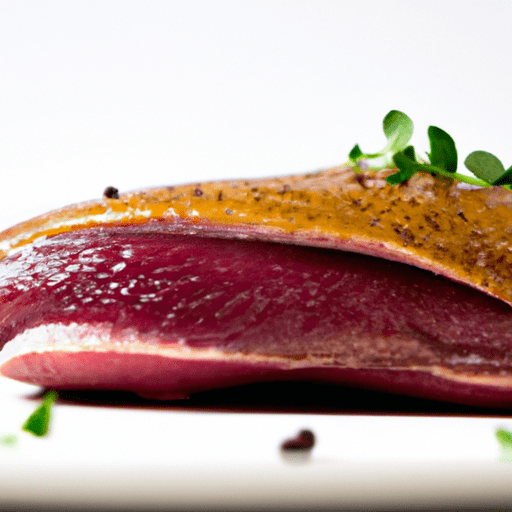All You Need to Know About Duck Breasts
When it comes to luxurious and succulent meat, duck breasts are a true delight. With their rich flavor and tender texture, they have become a favorite among food enthusiasts and professional chefs alike. In this article, we’ll delve into the world of duck breasts, exploring their taste, common uses in cooking, nutritional value, and some interesting history and facts. Let’s jump right in!
Taste and Texture
Duck breasts are known for their robust and distinctive flavor. The meat is savory, deeply rich, and typically slightly gamey. The fat content within the meat adds moisture and ensures a luscious mouthfeel. When cooked to perfection, duck breasts boast a wonderfully crispy skin, which adds another layer of texture and flavor to each delectable bite.
Common Uses in Cooking
Duck breasts offer a wide range of culinary possibilities. They are often pan-seared or grilled to achieve that perfect balance between tender meat and crispy skin. The versatility of duck breasts allows them to be prepared in various ways, such as being thinly sliced for salads or stir-fried dishes, or even used in hearty stews and braises.
One classic dish that showcases the indulgent nature of duck breasts is Duck à l’Orange. This French delicacy features succulent pan-seared duck breasts served with a tangy orange sauce, creating a harmonious combination of flavors. Another popular choice is Peking duck, a traditional Chinese dish that involves roasting a whole duck and then serving the tender slices with thin pancakes, scallions, and hoisin sauce.
Nutritional Value
Apart from their delectable taste, duck breasts are also packed with nutritional benefits. They are an excellent source of protein, which is essential for muscle growth and repair. Additionally, duck breasts contain essential vitamins and minerals, including iron, selenium, and zinc. However, it is crucial to note that duck meat, including the skin, is relatively high in fat, particularly saturated fat. Moderation is key when enjoying this flavorful meat.
Interesting History and Facts
Duck has held a significant place in culinary history for centuries. The Chinese have been rearing ducks for thousands of years, with records dating back to the Southern Song Dynasty. As a result, dishes like Peking duck, which originated in Beijing, have become iconic symbols of Chinese cuisine worldwide.
In Western cooking, duck has long been associated with French gastronomy. Its popularity soared during the Renaissance, particularly in France, where it was a favored choice among nobility. The French have since developed numerous exquisite preparations, elevating duck breasts to culinary stardom.
Duck breasts are a true delicacy that offers a rich and unforgettable dining experience. Their distinct flavor, versatile cooking methods, and nutritional value make them an excellent choice for those seeking a gourmet touch. Whether you’re preparing a romantic dinner or embarking on an adventurous culinary journey, duck breasts will definitely impress both your taste buds and your guests. So, consider adding this sumptuous meat to your next culinary creation and indulge in the exquisite flavors it has to offer.
Origin:
Duck is a domestic or wild bird that belongs to the Anatidae family, which also includes geese and swans. The domesticated duck is believed to have originated from the wild Mallard duck (Anas platyrhynchos) in East Asia. Ducks have been domesticated for thousands of years and are now widely farmed around the world for their meat and eggs.
Common Uses:
Duck breasts are highly versatile and popular in culinary applications. They are most commonly prepared by pan-searing or grilling to achieve a crispy skin while keeping the meat tender and juicy. Duck breasts can be served as a main course accompanied by various sauces, fruits, or vegetables. Additionally, they are commonly used in dishes like salads, stir-fries, and stews.
Nutritional Benefits:
Duck breasts provide several nutritional benefits. They are a good source of high-quality protein, essential vitamins, and minerals. In particular, they contain significant amounts of vitamin B5, vitamin B6, vitamin B12, and selenium. Duck breasts also offer healthy fats, including omega-6 fatty acids. However, it’s important to note that duck can be higher in fat compared to other poultry, so moderation in consumption is recommended.
Unique Properties and Historical Significance:
Duck meat is known for its unique flavor and rich, succulent texture. The layer of fat beneath the skin of duck breasts contributes to their tenderness and adds a distinctive taste. This flavor profile has made duck a popular ingredient in various cuisines around the world, including French, Chinese, and Middle Eastern.
Duck has a significant historical significance, particularly in Chinese cuisine. Roast Peking duck is an iconic dish with a history that dates back centuries in Beijing. The preparation involves inflating the skin by separating it from the meat and then air-drying the duck for a crispy skin. The dish is traditionally served with pancakes, green onions, cucumber, and hoisin sauce.
Duck shooting and hunting have been a traditional sport in many parts of the world, especially during the hunting season. In some places, it continues to be an important cultural activity and is closely associated with certain festivals and customs.
These are the factual details about duck breasts—its origin, common uses, nutritional benefits, and unique properties or historical significance.




Use the share button below if you liked it.
It makes me smile, when I see it.